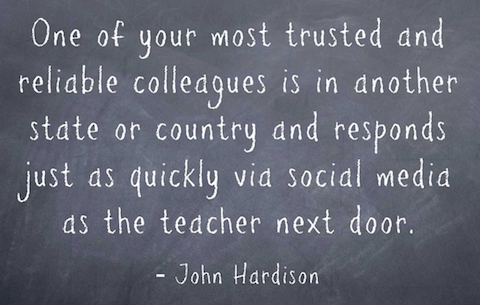You May Be a 21st Century Educator If…

You May Be a 21st Century Educator If…
1. You have theoretically received an #edchat doctoral degree from the “University of Twitter.” However, your monthly checks do not indicate an increase in pay that is equivalent to your acquired knowledge via the social media giant.
2. Google Maps on your smartphone is required to locate the nearest digital copier in your school because you haven’t visited the trance-inducing copy room in months.
3. Words like “flipped,” “blended,” “asynchronous,” “differentiated,” and “MOOC” are not words to describe how you feel after inhaling a chili hotdog just before riding a roller coaster called the “Vomit Van.” Instead, these words are part of your ever-increasing #edtech vocabulary.
4. Your classroom rarely has the same seating or furniture arrangement two days in a row.
5. Blogging serves as a continual venue for professional reflection and pedagogical sharing to help you improve your teaching strategies.
6. Counting the days until the summer break is not even a fraction as important as creating innumerable academic challenges to inspire greatness in your students.
7. Participating in a Saturday #edcamp for absolutely no compensation whatsoever in exchange for rubbing elbows with passionate teachers seems like one heck of a bargain.
8. One of your most trusted and reliable colleagues is in another state or country and responds just as quickly via social media as the teacher next door.
9. Websites such as cel.ly, Polleverywhere, TodaysMeet, Kahoot, and Twitter are common tech tools used to create backchannel discussions in your classroom.
10. You avoid collegial pessimism like Usain Bolt running from a rabid raccoon.
11. Fear and close-mindedness are eradicated in a courageous attempt to step out of your comfort zone and allow students to use smartphones as palmtops (laptops in the palms of their hands).
12. You eat lunch over a laptop while perusing top educational sites for new ideas.
13. Your students present you with the best form of educational feedback when the annoying bell rings and they collectively say, “Ahhhhhh, class is over already?”
14. Students are encouraged to take pictures of projected notes, classmates’ drawings, brainstorming ideas, or anything that will move their knowledge forward.
15. You are already getting excited about ISTE ’14 in Atlanta, Georgia.
16. Parents are asked to buy a few educational apps for their kids’ tablets and/or smartphones instead of the same old 3-ring binder and pencils.
17. Google Hangouts, Microsoft Lync, or Skype are common technology tools to help your students think outside the classroom by engaging with students from other schools in other districts, states, or even countries.
18. One of your workout sessions to de-stress from a tough day’s work turns into an effortless jog while a barrage of creative ideas initiate a seemingly endless foot race in your mind.
19. You operate according to the business model in your profession. In other words, if you don’t keep up with the current educational trends, your “product” will greatly suffer and your job will get the axe.
20. BrainHoney and Edmodo are not rappers in a nerdy group called Schoology but are instead digital learning platforms to organize, deliver, and manage your students’ class assignments.
21. Your answer to a colleague’s question “What research did you base your decisions on?” is simply, “My teacher’s heart and a gut feeling.”
22. Students are constantly asked to co-create their learning experiences with feedback solicited through a Google Form, verbal responses, and project-based learning contracts.
23. You can’t grab your smartphone quickly enough in the middle of the night to voice-record a creative idea for class.
24. Guidelines from the Fair Use Policy are forever etched in your immediate memory.
25. Interactive learning structures that integrate technology are constantly requested by students.
26. 8:05 PM on your wristwatch indicates you’re late for Sunday night’s #edchat meeting on Twitter.
27. Students in your class maintain a blog to share with a larger audience.
28. You encourage students to crowdsource their information by using websites like Padlet and RealTimeBoard.
29. Dry erase boards and smartphones are tools for creating a collaborative, digital notebook in Evernote or Google Drive.
30. It takes you all of June to recover from the previous school year. The physical and mental exhaustion, however, stems from a mind-blowingly creative class and not from putting out disciplinarian fires that resulted from students’ boredom or poor classroom management.
31. You’ve ever said, “Students, take out your smartphones and record me as I discuss this assignment. Then you can play it back as often as necessary.”
32. An up-to-date administrator observes your class and remarks on the remarkable learning noise and physical busy-ness of the students as they are engaged in active, hands-on, collaborative learning. Warning: The irony of this remark, combined with knowledge that the same comment many years earlier may have warranted the issuance of a professional development plan, could cause you to smirk or even roll your eyes.
33. Like Kevin Honeycutt, you make your professional practices and ideas as transparent and rewindable as possible.
34. You traded in the red pen for more nontraditional, feedback gadgets.
35. You ever had a teaching moment like this…and decided that it needed to be the very last.
36. Siri (and a trusty set of earbuds) has become your personal secretary as you tie up any loose ends from the day’s agenda while driving down the road towards home.
37. You inwardly snicker as a friend brags on his time-and-a-half overtime pay while you reminisce about a former student’s e-mail and how your countless extra hours and attention changed his life. Somehow, you always treat that like “double-time” pay…’cause Lord knows you would do it all over again just to see that kid smile.
38. You’re on an incessant search for tech tools (not tech toys) that will help students learn more efficiently, creatively, and collaboratively. Without a doubt, the learning objectives are the primary focus and educational technology is secondary.
39. A student has ever raised his hand, peaked once again at his BYOD gadget, and respectfully said, “Uhh, Mr. (eagerly awaiting teacher), Google disagrees with your statement.” Your reply? An honest “Thank you.”
40. The second week of the winter break has you bouncing off the walls from eagerness to jump back into the class and create learning magic.
41. You’ve ever “stunk it up” in class with a terrible lesson plan, expressed your frustration via a blog post from your phone, and sought feedback from your digital, professional learning network.
42. You consider yourself the “guide-on-the-side” or “facilitator-to-inspire-greater” instead of the “sage-on-the-stage.”
43. You KNOW that you have the best job in the world. Period.







Gino
Wonderful post! Thank you!
John McDermott Neill
Great post. Based on your ideas I'm a long way from 21st century but I hope I'll get there. Thanks for the share.
Regards,
John
K12 International Academy
Here is a look at our 21st Century Educators-- I think they meet the description!
http://icadinews.wordpress.com/2014/03/07/what-is-a-21st-century-educator/
Let me know what you think!